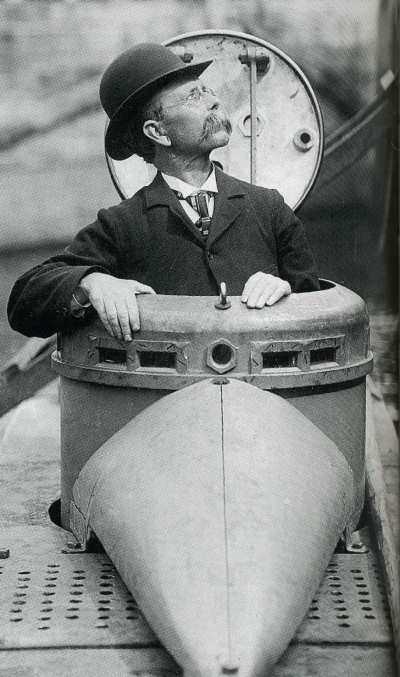1900 US Navy Accepts Submarine

John Philip Holland, an Irish engineer, pioneered modern submarine technology. His groundbreaking vessel, USS Holland (SS-1), was the first submarine purchased by the U.S. Navy in 1900. Featuring advanced propulsion and weaponry, Holland’s design laid the foundation for future naval submarines, revolutionizing underwater warfare and solidifying his legacy in naval engineering.
John Philip Holland, an Irish engineer and inventor, is widely regarded as the “father of the modern submarine” due to his pioneering work in underwater vessel design. Born in 1841 in County Clare, Ireland, Holland had an early fascination with mechanics and naval engineering, especially the idea of creating a vessel that could navigate underwater. This interest led him to develop multiple submarine prototypes throughout his life, culminating in a series of groundbreaking designs that would eventually catch the attention of the United States Navy.
Holland emigrated to the United States in 1873, where he worked as a schoolteacher while continuing to develop his ideas. His designs attracted support from the Fenian Brotherhood, an Irish republican organization that sought to use submarines to combat the British Navy. Holland’s early submarines, such as the Fenian Ram, were funded by the Fenians, but his relationship with the organization soured when they took control of the submarine without his permission. Despite this setback, Holland’s ambitions and ingenuity pushed him to pursue further development of submarine technology.
In the late 19th century, Holland’s innovative ideas began to gain the interest of the United States Navy, which was looking for new ways to strengthen its naval capabilities. He refined his designs, making significant advancements in submarine functionality, especially in propulsion and control. In 1896, he founded the John P. Holland Torpedo Boat Company, dedicated to building submarines. By 1897, Holland had created the Holland VI, a prototype that was both groundbreaking and functional, featuring advancements such as a gasoline-powered internal combustion engine for surface running and a battery-powered electric motor for submerged operations. These innovations allowed the vessel to dive, surface, and maneuver with unprecedented precision.
On April 11, 1900, after a series of successful tests and demonstrations, the United States Navy officially purchased the Holland VI, renaming it the USS Holland (SS-1). This made it the first submarine in the U.S. Navy’s fleet, marking a significant milestone in naval history. The USS Holland was 53 feet long, could reach speeds of up to seven knots on the surface, and could dive to a depth of 75 feet. It carried a single torpedo tube and was equipped with a pneumatic gun for launching projectiles, making it a formidable vessel for its time. The Navy’s purchase of the USS Holland was a testament to Holland’s expertise and vision, as it demonstrated the practical military value of submarines.
The USS Holland quickly became a model for subsequent U.S. Navy submarines. Its success helped establish Holland’s reputation as a leading innovator in naval engineering. Following the Navy’s adoption of his design, Holland continued to work on submarine technology, contributing to the development of other submarines, including those built by the Electric Boat Company, which later evolved into General Dynamics, a major defense contractor for the U.S. Navy.
Holland’s work laid the foundation for modern submarine warfare and naval strategy. His innovations in underwater navigation, propulsion, and weaponry set the stage for the evolution of submarines into essential assets for navies worldwide. John Philip Holland’s legacy lives on in the sophisticated submarines of today, which owe much of their technological roots to his groundbreaking achievements in the late 19th and early 20th centuries.
 >
>